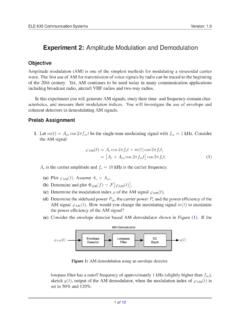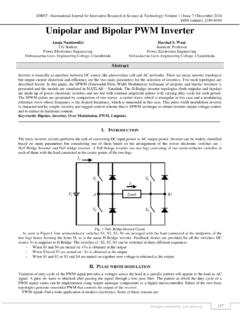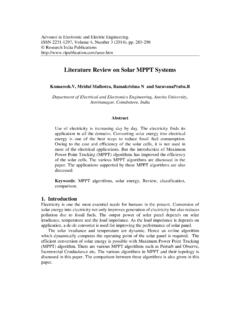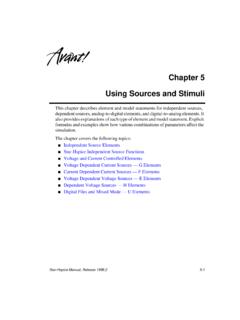Transcription of ELE745 Assignment and Lab Manual - Ryerson University
1 ELE745 Assignment and Lab ManualAugust 22, 2010 CONTENTS1. Assignment 1.. Assignment 1 Problems .. Assignment 1 Solutions .. 62. Assignment 2.. Assignment 2 Problems .. Assignment 2 Solutions .. 153. Assignment 3.. Assignment 3 Problems .. Assignment 3 Solutions .. 244. Assignment 4.. Assignment 4 Problems .. Assignment 4 Solutions .. 315. Experiment 1: Sampling Theory..396. Experiment 2: Binary Signalling Formats..417. Experiment 3: Matched Filter and Bit Error Rate (BER)..498. Experiment 4: Digital Modulation..561. Assignment Assignment 1 , figure shows Fourier spectra of signalsg1(t) andg2(t). Determine the Nyquistinterval and the sampling rate for signalsg1(t),g2(t),g21(t),g32(t), andg1(t)g2(t). , the Nyquist sampling rate and the Nyquist sampling interval for the signals:(a)sinc(100 t);(b)sinc2(100 t);(c)sinc(100 t) + sinc(50 t);(d)sinc(100 t) + 3sinc2(60 t);(e)sinc(50 t) sinc(100 t).
2 , signalg(t) = sinc2(5 t) is sampled (using uniformly spaced impulses) at a rate of: (i)5 Hz; (ii) 10 Hz; (iii) 20 Hz. For each of the three case:(a)Sketch the sampled signal;(b)Sketch the spectrum of the sampled signal;(c)Explain whether you can recover the signalg(t) from the sampled signal;1. Assignment 12(d)If the sampled signal is passed through an ideal low-pass filter of bandwidth 5 Hz,sketch the spectrum of the output , that a signal cannot be simultaneously time-limited and band-limited. Hint: showthat contrary assumption leads to contradiction. Assume a signal simultaneously time-limited and band-limited so thatG( ) = 0 for| |>2 B. In this caseG( ) =G( )rect( /4 B ) forB > B. This means thatg(t) is equal tog(t) 2B sinc(2 B t).Show that the latter cannot be , compact disc (CD) records audio signal digitally by using PCM. Assume the audiosignal bandwidth to be 15 kHz.
3 (a)What is the Nyquist rate?(b)If the Nyquist samples are quantized intoL= 65,536 levels and then binary coded,determine the number of binary digits required to encode a sample.(c)Determine the number of binary digits per second (bit/s) required to encode theaudio signal.(d)For practical reasons, signals are sampled at a rate well above the Nyquist CDs use 44,100 samples per second. IfL= 65,536, determine the numberof bits per second required to encode the , television signal (videl and audio) has a bandwidth of MHz. This signal is sampled,quantized, and binary coded to obtain a PCM signal.(a)What is the sampling rate if the signal is to be sampled at a rate 20% above theNyquist rate.(b)If the samples are quantized into 1024 levels, determine the number of binary pulsesrequired to encode each sample.(c)Determine the binary pulse rate (bits per second) of the binary-coded signal, andthe minimum bandwidth required to transmit this , telemetry signal, each of bandwidth 1 kHz, are to be transmitted simultaneouslyby binary PCM.
4 The maximum tolerable error in sample amplitudes is of the peaksignal amplitude. The signals must be sampled at least 20% above the Nyquist Assignment 13 Framing and synchronizing requires an additional extra bits. Determine the min-imum possible data rate (bits per second) that must be transmitted, and the minimumbandwidth required to transmit this , message signalm(t) is transmitted by binary PCM. If the SNR (signal-to-quantization-noise ratio) is required to be at least 47 dB, determine the minimum value ofLrequired,assuming thatm(t) is sinusoidal. Determine the SNR obtained with this , time averaging, find the average normalized power in the waveformx(t) = 10 cos 10t+20 cos , the sampling property of the unit impulse function to evaluate the following integrals.(a) cos 6t (t 3)dt(b) 10 (t) (1 +t) 1dt(c) 10 (t+ 4) (t2+ 6t+ 1)dt(d) exp( t2) (t 2) , (f) X2(f) for the spectra shown , an audio signal with spectral components limited to the frequency band 300 to3300 Hz.
5 Assume that a sampling rate of 8000 samples/s will be used to generate a PCMsignal. Assume that the ratio of peak signal power to average quantization noise powerat the output needs to be 30 Assignment 14(a)What is the minimum number of uniform quantization levels needed, and what isthe minimum number of bits per sample needed?(b)Calculate the system bandwidth (as specified by the main spectral lobe of the signal)required for the detection of such a PCM , waveform,x(t) = 10 cos(1000 t+ /3)+20 cos(2000 t+ /6) is to be uniformly sampledfor digital transmission.(a)What is the maximum allowable time interval between sample values that will ensureperfect signal reproduction?(b)If we want to reproduce 1 hour of this waveform, how many sample values need tobe stored? , signal in the frequency range 300 to 3300 Hz is limited to a peak-to-peak swing of 10V. It is sampled at 8000 samples/s and the samples are quantized to 64 evenly spacedlevels.
6 Calculate and compare the bandwidths and ratio of peak signal power to rmsquantization noise if the quantized samples are transmitted either as binary pulses or asfour-level pulses. Assume that the system bandwidth is defined by the main spectral lobeof the , the compact disc (CD) digital audio system, an analog signal is digitized so that theratio of the peak-signal power to the peak-quantization noise power is at least 96 dB. Thesampling rate is kilosamples/s.(a)How many quantization levels of the analog signal are needed for (S/Nq)peak=96dB?(b)How many bits per sample are needed for the number of levels found in part (a)?(c)What is the data rate in bits/s? , sampling, an analog signalg(t) is multiplied by a periodic train of rectangularpulsec(t), each of unit area. Given that the pulse repetition frequency of this period trainisfsand the duration of each rectangular pulse isT(withfsT <<1), do the following:1.
7 Assignment 15(a)Find the spectrum of the signals(t) that results from the use of natural sampling;you may assume that timet= 0 corresponds to the midpoint of a rectangular pulseinc(t).(b)Show that the original signalg(t) may be recovered exactly from its naturally sam-pled version, provided that the conditions embodied in the sampling theorem , voice signals are sampled uniformly and then time-division multiplexed. Thesampling operation uses flat-top samples with 1 sduration. The multiplexing operationincludes provision for synchronization by adding an extra pulse of sufficient amplitudeand also 1 sduration. The highest frequency component of each voice signal is kHz.(a)Assuming a sampling rate of 8 kHz, calculate the spacing between successive pulsesof the multiplexed signal.(b)Repeat your calculation assuming the use of Nyquist rate Assignment Assignment 1 : The bandwidth ofg1(t) andg2(t) are 100 kHz and 150 kHz, , the Nyquist sampling rates forg1(t) is 200 kHz, sampling intervalTs= 1/200k= 5 s the Nyquist sampling rates forg2(t) is 300 kHz, sampling intervalTs= 1/300k= s.
8 The bandwidth ofg21(t) is 200 kHz,fNyq= 400 kHz,fNyq= 1/400k= s. the bandwidth ofg32(t) is 450 kHz,fNyq= 900 kHz,fNyq= 1/900k= s. the bandwidth ofg1(t) g2(t) is 250 kHz,fNyq= 500 kHz,fNyq= 1/500k= 2 : sincesinc(100 t) ( 200 )the bandwidth of this signal is 100 rad/s or 50 Hz. The Nyquist rate is 100 Hz(samples/sec). sinc2(100 t) ( 400 )the bandwidth of this signal is 200 rad/s or 100 Hz. The Nyquist rate is 200 Hz(samples/sec). sinc(100 t) + sinc(50 t) ( 200 )+ ( 100 )the bandwidth of the first term on the right-hand side is 50 Hz and the second termis 25 Hz. Clearly the bandwidth of the composite signal is the higher of the two,that is, 100 Hz. The Nyquist rate is 200 Hz (samples/sec). sinc(100 t) + 3sinc2(60 t) ( 200 )+ ( 240 )the bandwidth of the first term is 50 Hz and that of the second term is 60 Hz. Thebandwidth of the sum is the higher of the two, that is, 60 Hz.
9 The Nyquist samplingrate is 120 Assignment 17 sinc(50 t) ( 100 )sinc(100 t) ( 200 )The two signals have BW 25 Hz and 50 Hz respectively. The spectrum of the productof two signals is 1/(2 ) times the convolution of their spectra. From width propertyof the convolution, the width of the convoluted signals is the sum of the widths ofthe signals convolved. Therefore, the BW of the product is 25+50=75 Hz. TheNyquist rate is 150 : The BW of the signalg(t) is 5 Hz (10 rad/s), since the FT as below:g(t) = sinc2(5 t) G( ) = ( 20 )Therefore, the Nyquist rate is 10 Hz, and the Nyquist interval isT= 1/10 = Whenfs= 5Hz, the spectrum1TG( ) repeats every 5 Hz (10 rad/sec). Thesuccessive spectra overlap, and the spectrumG( ) is not recoverable from G( ),that is,g(t) cannot be recovered from its samples. If the sampled signal is passedthrough an ideal lowpass filter of BW 5 Hz, the output spectrum is rect( /20 ), andthe output signal is 10sinc(20 t), which is not the desired signal sinc2(5 t).
10 Whenfs= 10Hz, the spectrum G( )consists of back-to-back, nonoverlapping rep-etition of1TG( ) repeating every 10 Hz. Hence,G( ) can be recovered from G( )using an ideal lowpass filter of BW 5 Hz ( (f)), and the output is 10sinc2(5 t). in the last case of oversampling (fs= 20 Hz), with empty band between successivecycles. Hence,G( ) can be recovered from G( ) using an ideal lowpass filter or evena practical lowpass filter. The output is 20sinc2(5 t). : assuming a signalg(t) that is simultaneously time-limited and ( ) = 0 for| |>2 B. Therefore,g( )rect( 4 B )=g( )for B > , from the time-convolution propertyg(t) =g(t) [2B sinc(2 B t)] = 2B g(t) sinc(2 B t).Becauseg(t) is time-limited,g(t) = 0 for|t|> T. Butg(t) is equal to convolution ofg(t) with sinc(2 B t) which is not time-limited. It is impossible to obtain a time-limitedsignal from the convolution of a time-limited signal with a non-timelimited Assignment :(a): the bandwidth is 15 kHz.






